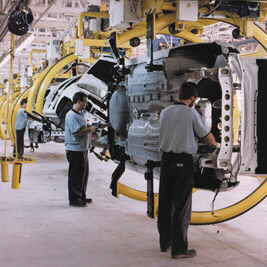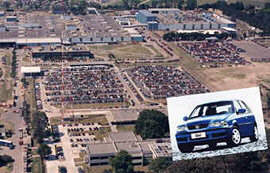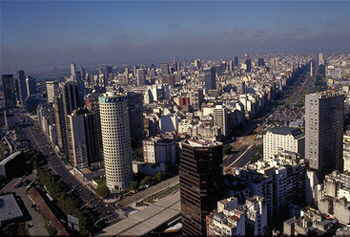 ARGENTINA, FROM SOVIET STYLE CENTRALIZED ECONOMY TO FREE TRADE MECCA ARGENTINA, FROM SOVIET STYLE CENTRALIZED ECONOMY TO FREE TRADE MECCA |
Argentina, for generations an airtight economy highly suspicious of foreign investment and whose only interest in international commerce was to ensure smooth delivery of its grain and beef shipments, last decade took an abrupt U-turn and has now become a free trade Mecca.
In 1991 Cavallo, during the Menem administration, became the architect of the country’s transformation from a closed economy to a world paradigm of free-market policies, aggressively seeking to attract foreign direct investment, privatizing state-run companies and, most importantly, embarking on a free trade path.
Soon the country joined forces with its neighbors to set up the Mercosur trading bloc and has more recently become a key advocate of Washington’s Free Trade Area of the Americas proposal.

Mercosur has been one of the largest and most successful integrated markets in the developing world, with substantial foreign investment going to its members. The quote does not come from an Argentine government brochure but from an official White House document assessing the trading bloc, which also has Chile and Bolivia as associate members.
Intra-Mercosur commerce rose dramatically from $4 billion in 1991 to over $17 billion in 1998. More than 90 percent of intra-Mercosur trade is duty-free, while the group's common external tariff (CET) applies to more than 85 percent of imported goods. Remaining goods will be phased into the CET by 2006.
 A $1 trillion output trading bloc A $1 trillion output trading bloc |
Perhaps more importantly, joining forces meant that Southern Cone countries were able to attract several billions of dollars a year in foreign direct investment flows allured by a 200 million people, $1 trillion combined GDP trading bloc - the fourth largest economy in the world after Nafta, the European Union and Japan.
However, since 1999 trade between Brazil and Argentina, the two major economies in the regional union, took a hard hit after Brazil devalued its currency. Argentine sales to Brazil that year nose-dived to $7.1 billion from $9.4 billion in 1998. Imports from Brazil also suffered, as the country plunged into the longest recession in its recent history.
At the same time, sales to Nafta member nations (the United States, Canada and Mexico), continued to rise steadily as they were not affected by currency fluctuations.
This has led several economists in Argentina to suggest that the country would be a lot better off seeking a quick entry into the FTAA, even if it had to go its own way instead of doing it as part of Mercosur as originally planned.
This view gained more Argentine supporters during the Summit of the Americas held last April in Quebec, Canada. There the Bush Administration pushed hard to bring forward to 2003 (from the original 2005) the conclusion of the FTAA negotiations, but Brazil was dead set against the proposal.
In the end the longer-term approach prevailed, but the debate in Argentina about whether to go along with Mercosur or take a faster pace to gain tariff-free access to the world’s largest economy as soon as possible still remains open.
 Cavallo a Mercosur skeptic? Cavallo a Mercosur skeptic? |
In a bid to put the issue to rest, President De la Rua and his Brazilian counterpart Fernando Henrique Cardoso met in Quebec during the Americas Summit and later proclaimed that their nations would go into the FTAA talks through Mercosur and not individually.
But the critics’ ranks gained a key supporter -- Cavallo himself, who in the past few months has been singing the virtues of the FTAA and complaining about difficulties within Mercosur, setting off alarms in Brazil.
The current Economy Minister doesn’t appear to be in favor of Brazil anymore, complains Eloi Rodrigues de Almeida, chairman of the Brazil Group, which represents 190 companies conducting $8 billion worth of business in Argentina.
He was speaking immediately after Cavallo, in a bid to help out several local industries badly affected by the economic slump, brought down capital goods import tariffs to zero. This hurt Brazilian companies who lost their tariff edge on European, American and Asian competitors.

But in Argentina, where anti-Mercosur sentiment was on the rise, the move was widely welcome. The whispered collective feeling was, If the Brazilians can take unilateral measures that hurt us in order to protect their own industry, why can’t we give them a little of their own medicine?”
To be sure, a growing number of industrialists, from textile makers to carmakers, now are pointing their fingers at the titanic neighbor (Brazil’s economy, twice the size of Argentina’s, is the 10th largest in the world), accusing it of a whole array of unfair trade practices, including dumping and devaluations to turn the trade balance in its favor.
 Brazil devaluation’s side effects Brazil devaluation’s side effects |
All was going very well until the Brazilian crisis started in October 1997, laments Cristiano Rattazzi, president of Fiat Auto Argentina.
The industry was expecting sales of 3 million cars to the Mercosur and we found out that sales decreased to about half that amount. Fiat Auto Argentina had been organizing the company for this broad market. We have never recovered from that crisis.”

Former Austrian Chancellor Viktor Klima, who now chairs Volkswagen Argentina, fully agrees with his colleague from Fiat.
The problem with Mercosur is Brazil, because it’s a dominant country. Brazil has not understood that if they want to succeed within Mercosur, they need to co-ordinate efforts and policies with their smaller partners, he admonishes.
Other automobile makers have similar stories to tell. So have many other industrialists from dozens of different sectors whose businesses flourished during several years thanks to strong sales to Brazil and then plunged when a series of devaluations put their goods farther and farther out of reach of Brazilian customers.
| Guillermo Gotelli, President of Alpargatas, a century-old company that used to be a leading footwear and textile maker and now has run up $500 million in debts, is one vocal critic. In terms of the textile sector, the problem was that Brazil was dumping its products onto Argentina, he complains.
Like so many of his colleagues, Gotelli believes that looking further north can be more convenient at this point in time, particularly so now that the country is also in free trade talks with Mexico, another Nafta member.
If the North American Free Trade Agreement (Nafta) has good results, we will have to focus more on Mexico and try to find there the proper partner. If the Mercosur delays the Free Trade Agreement with the American market, we will have to reconsider our relationship with Brazil, he said bluntly.
Mexico, Latin America’s second largest economy after Brazil, is also a major car maker. But Argentine producers don’t see it as a major competitor because Mexicans focus on large vehicles that are in big demand in the United States, while Argentines specialize in mid-sized and compact units more adequate for Latin American markets, where the purchasing power is lower and gasoline more expensive.
 Global economy no place for mavericks Global economy no place for mavericks |
The Brazil Group’s Rodrigues de Almeida, while not denying the problems that have emerged between the two neighbors, tries to put them in a positive light.
I always say that if there’s no conflict, there’s no commerce, he reasons. If there’s political or economic conflict between the partners it is because there are a lot of business opportunities. But despite our differences, we trust that the Mercosur is irreversible, he stresses.

In the middle of that rarified atmosphere, many contend that Argentina and Brazil need each other badly. Not just because bilateral trade has grown to such major proportions, but most importantly because in today’s global economy going solo could be suicidal.
This is particularly true for Argentina, which although a lot richer in per capita terms than Brazil (or any other Latin American country, for that matter), is a 37-million market - almost insignificant when compared with its neighbor’s 170 million souls.
And even staunch Brazil critics such as Alpargatas’ Gotelli agree that that country’s piecemeal approach when it comes to lowering trade barriers (a slow-motion pace that often irritates Argentine and American negotiators alike), can have its benefits as it gives more time to companies to accommodate to the new scenario.
The problem was that Argentina opened its market very aggressively. The foreign players took a substantial part of the markets and reduced margins, creating a lot of financial risks, he points out.
 Subsidies and non-tariff barriers Subsidies and non-tariff barriers |
Ironically enough, the United States, an undisputed champion of free trade, also has its own peccadilloes—on top of the age-old subsidies to American farmers, which anger grain, dairy and beef producer Argentina, the White House is also seeking to severely restrict imports of steel, again a key hard-currency earner for the South American country.
Citing deep concern about the situation of the U.S. steel industry, which is going through one of the worst crises in its history, President Bush in June ordered investigative actions aimed at clamping quotas and countervailing duties on steel imports, a move that Argentine producers complain is purely politically-motivated and could cost them up to $200 million a year in lost revenues.
And the list of trade complaints against Washington doesn’t end there either. It also includes import quotas on many of Argentine main export goods as well as the use of labor, phytosanitary and environmental considerations as a non-tariff shield to protect American producers from foreign competitors, Argentine trade experts say.
Under this light, the mood of local businessmen, always quick to see the straw in other peoples’ eyes and not the beam in their own, swings again and leads them to perceive Brazil not as a contender but as a potential ally who could champion their common cause before the world’s number one power.
For one thing, many of them have little faith in their own leaders’ bargaining skills. The World Trade Organization (WTO) has the right tools to fight protectionism, the problem is that the Argentine government does not know how to use them, protests Alpargatas’ Gotelli.
For another, they all recognize that Brazil always was one tough bargainer and that all it would take to benefit from its mighty negotiating power is joining forces with it and let it lead the discussions with Washington over the FTAA terms of entry. In other words, their rationale appears to be, If it’s a sumo wrestler, lets have it on our side, not against us.”
 "Free trade is inevitable” "Free trade is inevitable” |
Only time will tell which of the two stances prevails.
But from an American perspective, all the brouhaha over whether Argentina should walk into the negotiating room alone or hand in hand with Brazil is futile. What really counts, says the permanent U.S. envoy to Buenos Aires James Walsh, is that free trade is a global trend and that it is inevitable.
Modalities of how you bring nations into the whole seem to me almost secondary to the main point, which is that you essentially have a true free trade area in the entire hemisphere, the ambassador says. Free trade is coming one way or the other.”

Together or separate, once Brazil and Argentyna gain access to a broader free commerce arrangement, much of their bickering may become history, trade experts say, as an FTAA would inherit from Nafta a solid legal framework and reliable institutions, including dependable dispute-settlement mechanisms.
That would be a major departure from the past -- while Mercosur has succeeded in boosting trade amongst its members, what exactly to do every time problems arose has been one of its Achilles heels over the years. |

